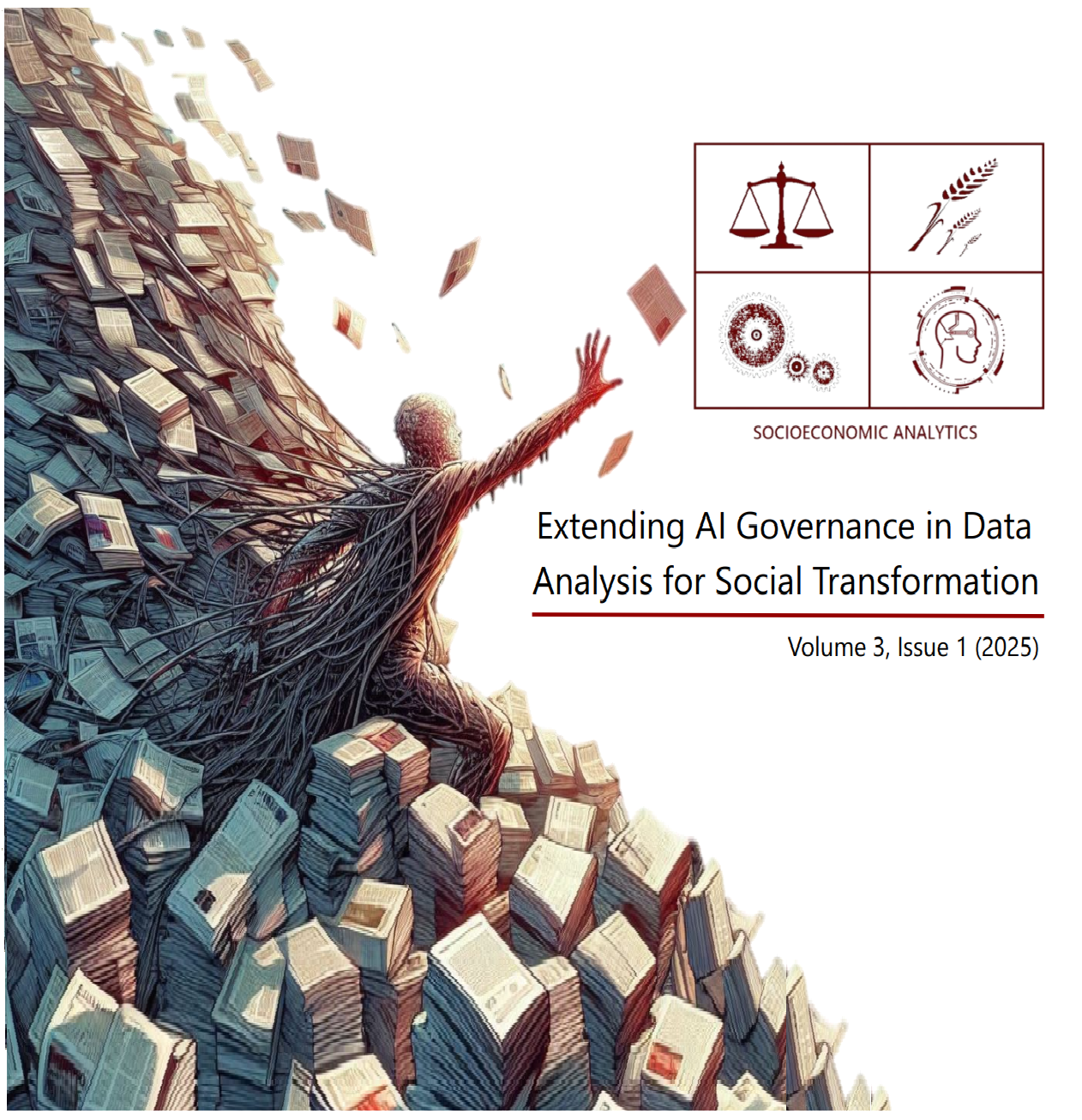Social Network Analysis of Occupational Structures: A Case Study of Brazil, China, Germany, Russia, and the United States
DOI:
https://doi.org/10.29327/2565368.3.1-1Keywords:
Social Stratification, Network Analysis, Occupational Structure, Global Capitalism, Class-Based AnalysisAbstract
This article investigates the complex dynamics of social stratification in the context of contemporary global capitalism, with a particular focus on the interplay of class positions and occupational categories across five major countries: Brazil, China, Germany, Russia, and the United States. The study aims to offer a nuanced understanding of social hierarchies by integrating network analysis into the examination of socioeconomic and occupational structures, providing an innovative methodological approach to traditional class-based analysis
References
Akers, L. (2022). Individual Differences in Stances Toward Societal Meta-Narratives. Available in https://psyarxiv.com/4epv6/download/?format=pdf. Last accessed 14/05/2025.
Amoranto, G., Chun, N., & Deolalikar, A. B. (2010). Who are the middle class and what values do they hold? Evidence from the World Values Survey. Evidence from the World Values Survey (October 1, 2010). Asian Development Bank Economics Working Paper Series, (229).
Bauer, G. R., Churchill, S. M., Mahendran, M., Walwyn, C., Lizotte, D., & Villa-Rueda, A. A. (2021). Intersectionality in quantitative research: A systematic review of its emergence and applications of theory and methods. SSM-population health, 14, 100798.
Berenstain, N., Dotson, K., Paredes, J., Ruíz, E., & Silva, N. K. (2022). Epistemic oppression, resistance, and resurgence. Contemporary Political Theory, 21(2), 283
Bezpalov, V., Lochan, S., & Fedyunin, D. (2020). The Signs of Economic Disparity in Russia Following the Implosion of the USSR. Visual Anthropology, 33, 116 - 127. https://doi.org/10.1080/08949468.2020.1721200.
Bezpalov, V., Lochan, S., & Fedyunin, D. (2020). The Signs of Economic Disparity in Russia Following the Implosion of the USSR. Visual Anthropology, 33, 116 - 127. https://doi.org/10.1080/08949468.2020.1721200.
Białowolski, P. (2015). Concepts of confidence in tendency survey research: An assessment with multi-group confirmatory factor analysis. Social Indicators Research, 123(1), 281-302.
Bourdieu, P. (1984). Distinction: A Social Critique of the Judgment of Taste. Harvard University Press.
Bourdieu, P. (1991). The Craft of Sociology: Epistemological Preliminaries. Walter de Gruyter.
Bowleg, L. (2008). When Black+ lesbian+ woman≠ Black lesbian woman: The methodological challenges of qualitative and quantitative intersectionality research. Sex roles, 59, 312-325.
Bright, L. K., Malinsky, D., & Thompson, M. (2016). Causally interpreting intersectionality theory. Philosophy of Science, 83(1), 60-81.
Christensen, A. D., & Jensen, S. Q. (2012). Doing intersectional analysis: Methodological implications for qualitative research. NORA-Nordic Journal of Feminist and Gender Research, 20(2), 109-125.
Clark, T. N., & Lipset, S. M. (2014). Are social classes dying? 1. In Conflicts about Class (pp. 42-48). Routledge.
Collins, P. H. (2015). Intersectionality's definitional dilemmas. Annual Review of Sociology, 41, 1-20.
Collins, P. H. (2019). Intersectionality as Critical Social Theory. Duke University Press.
Connelly, R., Gayle, V., & Lambert, P. S. (2016). A Review of occupation-based social classifications for social survey research. Methodological Innovations, 9. https://doi.org/10.1177/2059799116638003.
Crenshaw, K. (1989). Demarginalizing the intersection of race and sex: A black feminist critique of antidiscrimination doctrine, feminist theory and antiracist politics. University of Chicago Legal Forum, 1989(1), 139-167.
Crenshaw, K. (1991). Mapping the margins: Intersectionality, identity politics, and violence against women of color. Stanford Law Review, 43(6), 1241-1299.
Dill, B. T., & Kohlman, M. H. (2012). Intersectionality: A transformative paradigm in feminist theory and social justice. In Handbook of feminist research: Theory and praxis (2nd ed., pp. 154-174). SAGE Publication
Dirlik, Arif (2003). Global Modernity?: Modernity in an Age of Global Capitalism. European Journal of Social Theory 6 (3):275-292.
Dotson, K. (2011). Tracking epistemic violence, tracking practices of silencing. Hypatia, 26(2), 236-257.
Dubrow, J. K. (2008). How can we account for intersectionality in quantitative analysis of survey data? Empirical illustration for Central and Eastern Europe. ASK. Research & Methods, 17, 85-100.
Elster, J. (1989). Explaining social behavior: More nuts and bolts for the social sciences. Cambridge University Press.
Erro-Garcés, A., & Aranaz-Núñez, I. (2020). Catching the wave: Industry 4.0 in BRICS. Journal of Manufacturing Technology Management, 31, 1169-1184. https://doi.org/10.1108/jmtm-09-2019-0344.
Erro-Garcés, A., & Aranaz-Núñez, I. (2020). Catching the wave: Industry 4.0 in BRICS. Journal of Manufacturing Technology Management, 31, 1169-1184. https://doi.org/10.1108/jmtm-09-2019-0344.
Fachelli, S., & Roldán, P. L. (2012). Two models of social stratification: from a classification scheme to a typology. In Ponencia presentada en The Second ISA Forum of Sociology “Social justice and democratization”, Buenos Aires, Argentina (Vol. 1).
Ferrand, A., Mounier, L., & Degenne, A. (2018). The diversity of personal networks in France: Social stratification and relational structures. In Networks in the global village (pp. 185-224). Routledge.
Gross, C., & Goldan, L. (2023). Modelling intersectionality within quantitative research. sozialpolitik. ch, (1/2023), 1-3.
Gross, J. L., Yellen, J., & Anderson, M. (2018). Graph theory and its applications. Chapman and Hall/CRC.
Haerpfer, C., Inglehart, R., Moreno, A., Welzel, C., Kizilova, K., Diez-Medrano J., M. Lagos, P. Norris, E. Ponarin & B. Puranen (eds.). (2022). World Values Survey: Round Seven - Country-Pooled Datafile Version 5.0. Madrid, Spain & Vienna, Austria: JD Systems Institute & WVSA Secretariat. https://doi.org/10.14281/18241.20.
Hennig, C., & Liao, T. F. (2010). Comparing latent class and dissimilarity based clustering for mixed type variables with application to social stratification. Technical report.
Hennig, C., & Liao, T. F. (2013). How to find an appropriate clustering for mixed-type variables with application to socio-economic stratification. Journal of the Royal Statistical Society: Series C (Applied Statistics), 62(3), 309–369. https://doi.org/10.1111/j.1467-9876.2012.01066.x.
Hinze, S. W., Lin, J., & Andersson, T. E. (2012). Can we capture the intersections? Older Black women, education, and health. Women's Health Issues, 22(1), e91-e98.
Huang, X. (2021). Subjective Class Identification in Australia: Do Social Networks Matter?. The Sociological Quarterly, 64, 123-143. https://doi.org/10.1080/00380253.2021.1997668.
Huang, X. (2021). Subjective Class Identification in Australia: Do Social Networks Matter?. The Sociological Quarterly, 64, 123 - 143. https://doi.org/10.1080/00380253.2021.1997668.
Inglehart, R. (2020). Modernization and postmodernization: Cultural, economic, and political change in 43 societies. Princeton University Press.
Kline, B., & Tamer, E. (2020). Econometric analysis of models with social interactions. In The Econometric Analysis of Network Data (pp. 149-181). Academic Press.
Kok, A. A., Huisman, M., Cooper, R., Cosco, T. D., Deeg, D. J., Kuh, D., & Stafford, M. (2020). Lifetime trajectories of socio-economic adversity and their associations with psychosocial factors and attitudes towards social class. Longitudinal and Life Course Studies, 11(1), 81-104.
Lambert, P., & Griffiths, D. (2018). Social Inequalities and Occupational Stratification: Methods and concepts in the analysis of social distance. Springer.
Lestari, K. W., & Playford, C. (2023, November). Married Women Employment: Multinomial Logistic Regression Analysis of Marital Status, Education Level, and Age on Women Career. In Proceeding Book of The International Conference on Manpower and Sustainable Development: Transformation of Manpower in the Changing World of Work (Vol. 1).
Lizón, A. (2007). La otra sociología. Una saga de empíricos y analíticos. Ediciones de Intervención Cultural y Universidad Nacional Autónoma de México.
Loureiro, P. (2019). Class inequality and capital accumulation in Brazil, 1992–2013. Cambridge Journal of Economics. https://doi.org/10.1093/CJE/BEZ030.
Loureiro, P. (2019). Class inequality and capital accumulation in Brazil, 1992–2013. Cambridge Journal of Economics. https://doi.org/10.1093/CJE/BEZ030.
Lukac, M., Doerflinger, N., & Pulignano, V. (2019). Developing a cross-national comparative framework for studying labour market segmentation: Measurement equivalence with latent class analysis. Social Indicators Research, 145(1), 233-255.
McLevey, J. (2021). Doing Computational Social Science: An Introduction. SAGE Publications.
Mac-Clure, O., Barozet, E., & Valenzuela, A. (2020). Naming oneself in the social mirror: A vignette-based survey. Current Sociology. https://doi.org/10.1177/0011392120932953.
Mac-Clure, O., Barozet, E., & Valenzuela, A. (2020). Naming oneself in the social mirror: A vignette-based survey. Current Sociology. https://doi.org/10.1177/0011392120932953.
Molina, K. M., Alegría, M., & Mahalingam, R. (2013). A multiple-group path analysis of the role of everyday discrimination on self-rated physical health among Latina/os in the USA. Annals of Behavioral Medicine, 45(1), 33-44.
Muthukrishna, M., Bell, A. V., Henrich, J., Curtin, C. M., Gedranovich, A., McInerney, J., & Thue, B. (2020). Beyond Western, Educated, Industrial, Rich, and Democratic (WEIRD) psychology: Measuring and mapping scales of cultural and psychological distance. Psychological science, 31(6), 678-701.
Pivecka, N., Kunz, S., & Florack, A. (2023). Social class differences in dietary intake are mediated by the relationship between health and taste: Findings from a cross-sectional and longitudinal study. Food Quality and Preference, 109, 104914.
Ramos, S. R., Lardier Jr, D. T., Opara, I., Turpin, R. E., Boyd, D. T., Gutierrez Jr, J. I., ... & Kershaw, T. (2021). Intersectional effects of sexual orientation concealment, internalized homophobia, and gender expression on sexual identity and HIV risk among sexual minority men of color: A path analysis. The Journal of the Association of Nurses in AIDS Care, 32(4), 495-508.
Rawolle, S., & Lingard, B. (2022). Bourdieu and educational research: Thinking tools, relational thinking, beyond epistemological innocence. In Social theory and education research (pp. 161-181). Routledge.
Rice, C., Harrison, E., & Friedman, M. (2019). Doing justice to intersectionality in research. Cultural Studies↔ Critical Methodologies, 19(6), 409-420.
Rojas Ospina, D. E. (2020). Relaciones de clase y estratificación social desde la perspectiva de la sociología analítica. Sociológica México, (99).
Rojas Ospina, D. E. (2023). Identificación de tipologías sociodemográficas de la fuerza laboral ocupada venezolana en Bogotá: una comparación con la fuerza laboral ocupada nacional utilizando datos de GEIH y análisis de conglomerados. Sociología del Trabajo, (102).
Romero, M. (2017). Introducing intersectionality. John Wiley & Sons
Roseneil, S. (2013). Beyond ‘the relationship between the individual and society’: Broadening and deepening relational thinking in group analysis. Group Analysis, 46(2), 196-210.
Saez, E., & Zucman, G. (2020). The Rise of Income and Wealth Inequality in America: Evidence from Distributional Macroeconomic Accounts. NBER Working Paper Series. https://doi.org/10.3386/w27922.
Saez, E., & Zucman, G. (2020). The Rise of Income and Wealth Inequality in America: Evidence from Distributional Macroeconomic Accounts. NBER Working Paper Series. https://doi.org/10.3386/w27922
Savage, M., Devine, F., Cunningham, N., Taylor, M., Li, Y., Hjellbrekke, J., Le Roux, B., Friedman, S., & Miles, A. (2013). A New Model of Social Class? Findings from the BBC’s Great British Class Survey Experiment. Sociology, 47(2), 219-250.
Spector-Mersel, G. (2010). Narrative research: Time for a paradigm. Narrative Inquiry, 20(1), 204-224. Retrieved from https://www.academia.edu/download/75484026/spector-mersel-time-for-a-paradigm.pdf
Susen, S. (2015). The postmodern turn in the social sciences (p. 510). Basingstoke: Palgrave Macmillan.
Weeden, K. A., & Grusky, D. B. (2004). Are there any big classes at all?. Research in Social Stratification and Mobility, 22, 3-56.
Yang, R., Zhong, C., Yang, Z., & Wu, Q. (2022). Analysis on the Effect of the Targeted Poverty Alleviation Policy on Narrowing the Urban-Rural Income Gap: An Empirical Test Based on 124 Counties in Yunnan Province. Sustainability. https://doi.org/10.3390/su141912560.
Yang, R., Zhong, C., Yang, Z., & Wu, Q. (2022). Analysis on the Effect of the Targeted Poverty Alleviation Policy on Narrowing the Urban-Rural Income Gap: An Empirical Test Based on 124 Counties in Yunnan Province. Sustainability. https://doi.org/10.3390/su141912560.
Yassine, L. (2019). To know is to exist: Epistemic resistance. In Disrupting whiteness in social work (pp. 91-107). Routledge.
Zaninotto, P., Batty, G. D., Stenholm, S., Kawachi, I., Hyde, M., Goldberg, M., ... & Head, J. (2020). Socioeconomic inequalities in disability-free life expectancy in older people from England and the United States: a cross-national population-based study. The journals of gerontology: Series A, 75(5), 906-913.
Downloads
Additional Files
Published
Issue
Section
License
Copyright (c) 2025 David Esteban Rojas Ospina

This work is licensed under a Creative Commons Attribution-NonCommercial-NoDerivatives 4.0 International License.
Authors who publish with Socioeconomic Analytics retain the copyright of their work and agree to license it under a Creative Commons Attribution-NonCommercial-NoDerivatives 4.0 International (CC BY-NC-ND 4.0) license. This means that the work can be shared, copied, and redistributed in any medium or format, as long as it is not used for commercial purposes, and the original work is properly cited. The work cannot be changed in any way or used to create derivative works.










